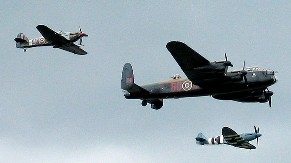The Battle of Britain was a fight for air superiority that began at the end of July, 1940. The Luftwaffe (the German air force) was hoping to destroy the RAF (the British Royal Air Force) so that the German army could cross the English Channel and launch an invasion of Britain – code named Operation Sea Lion.
The Luftwaffe comprised of 6,000 pilots, 1,600 bombers and 1,100 fighter planes, mostly Messer Schmitt 109s and 110s. At the start of the Battle the RAF had just 1,500 pilots for a fleet of 850 fighters, made up of Spitfires and Hurricanes. In terms of the ‘fighter plane hierarchy’ Spitfires were in pole position, followed by Messer Schmitt 109s, then Hurricanes.
Although the numbers were in the favour of the Luftwaffe, the RAF had a good set of tactics and support, and the better aircraft. A great radar system gave RAF pilots early warning of the approaching Luftwaffe, allowing them to remain on the ground, conserving fuel and pilot energy. At the last minute the order to ‘scramble’ would be given and pilots would race to their planes and climb to altitudes above the German planes to use surprise as a major weapon. As the Battle went on the RAF was able to recruit many more pilots, particularly from countries that had been overrun or were part of the British Empire.
 The Luftwaffe didn’t seem to have such a solid plan of attack, sometimes concentrating on the Channel and sometimes hitting cities across the whole of the British southern coast. One of the defining thoughts was ‘the bomber will always get through’ to target ground objects, whilst the RAF was focussed on the planes. This might have because the German officials never made any real plans for Operation Sea Lion. Following the French surrender on June 17th 1940 a surrender was offered to Britain, which was unexpectedly refused, and in addition the upcoming invasion of Russia became increasingly distracting. For the British people however it was one of the most important moments of World War II and their success was seen as vital to their survival.
The Luftwaffe didn’t seem to have such a solid plan of attack, sometimes concentrating on the Channel and sometimes hitting cities across the whole of the British southern coast. One of the defining thoughts was ‘the bomber will always get through’ to target ground objects, whilst the RAF was focussed on the planes. This might have because the German officials never made any real plans for Operation Sea Lion. Following the French surrender on June 17th 1940 a surrender was offered to Britain, which was unexpectedly refused, and in addition the upcoming invasion of Russia became increasingly distracting. For the British people however it was one of the most important moments of World War II and their success was seen as vital to their survival.
The featured image is from Paul and the Lancaster Bomber, Spitfire and Hurricane is from O Palsson, both used and edited with thanks under the Creative Commons License.